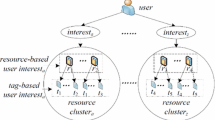Abstract
With the development of the web, smart devices, and social networks, the utilization of tags has increased. This study proposes a recommendation system that can be used in tag-based web services. This study measures the user’s preference and similarity by reflecting the frequency and timing of the use of tags. In particular, this study reflected the tagging time on a cardinal scale for more precise information. To evenly consider the size of the neighbors, the size is systematically surveyed from 3 to 30. In the process of determining the recommendation, a methodological combination is constructed by reflecting preferences and similarities without mutual dependence. Actual big data of social bookmark users were collected and applied to verify performance. Precision, Recall, and F-ratio were measured as verification indicators. The analysis results found that techniques with the best performance among the proposed algorithms were superior to benchmarks in all indicators. The methodology and results of this study may be applicable to various tagging systems.
Access this chapter
Tax calculation will be finalised at checkout
Purchases are for personal use only
Similar content being viewed by others
References
Highfield, T., Leaver, T.: A methodology for mapping Instagram hashtags. First Monday 20(1), 1–11 (2015)
Giannoulakis, S., Tsapatsoulis, N.: Evaluating the descriptive power of Instagram hashtags. J. Innov. Digit. Ecosyst. 3(2), 114–129 (2016)
Bruns, A., Burgess, J.: The use of Twitter hashtags in the formation of ad hoc publics. In: Proceedings of the 6th European Consortium for Political Research (ECPR) General Conference, pp. 1–9. The European Consortium for Political Research (ECPR), Reykjavik (2011)
Klemperer, P., et al.: Tag, you can see it! Using tags for access control in photo sharing. In: Proceedings of the SIGCHI Conference on Human Factors in Computing Systems, Austin, pp. 377–386 (2012)
Ibba, S., Orrù, M., Pani, F.E., Porru, S.: Hashtag of Instagram: from folksonomy to complex network. In: Proceedings of the 7th International Joint Conference on Knowledge Discovery, Knowledge Engineering and Knowledge Management, Lisbon, pp. 279–284 (2015)
Shardanand, U., Maes, P.: Social information filtering: algorithms for automating ‘‘word of mouth”. In: The SIGCHI Conference on Human Factors in Computing Systems, Seoul (1995)
Sarwar, B., Karypis, G., Konstan, J., Riedl, J.: Analysis of recommendation algorithms for E-commerce. In: The Second ACM Conference on Electronic Commerce, Minneapolis (2000)
Breese, J.S., Heckerman, D., Kadie, C.: Empirical analysis of predictive algorithms for collaborative filtering. The 14th Conference on Uncertainty in Artificial Intelligence, San Franciso (1998)
Najafabadi, M.K., Mohamed, A., Onn, C.W.: An impact of time and item influencer in collaborative filtering recommendations using graph-based model. Inf. Process. Manage. 56(3), 526–540 (2019)
Zhang, C., Yang, M., Lv, J., Yang, W.: An improved hybrid collaborative filtering algorithm based on tags and time factor. Big Data Min. Anal. 1(2), 128–136 (2018)
Yang, S., Korayem, M., AlJadda, K., Grainger, T., Natarajan, S.: Combining content-based and collaborative filtering for job recommendation system: a cost-sensitive Statistical Relational Learning approach. Knowl. Based Syst. 136, 37–45 (2017)
Shang, M.-S., Zhang, Z.-K., Zhou, T., Zhang, Y.-C.: Collaborative filtering with diffusion-based similarity on tripartite graphs. Phys. A 389(6), 1259–1264 (2010)
Salton, G., McGill, M.J.: Introduction to Modern Information Retrieval. McGraw-Hill, New York (1983)
Najafabadi, M.K., Mahrin, M.N., Chuprat, S., Sarkan, H.M.: Improving the accuracy of collaborative filtering recommendations using clustering and association rules mining on implicit data. Comput. Hum. Behav. 67, 113–128 (2017)
Tewari, A.S., Barman, A.G.: Sequencing of items in personalized recommendations using multiple recommendation techniques. Expert Syst. Appl. 97, 70–82 (2018)
Author information
Authors and Affiliations
Corresponding author
Editor information
Editors and Affiliations
Rights and permissions
Copyright information
© 2023 The Author(s), under exclusive license to Springer Nature Switzerland AG
About this paper
Cite this paper
Jo, H. (2023). A Recommendation System Based on Big Data: Separation of Preference and Similarity. In: Arai, K. (eds) Intelligent Systems and Applications. IntelliSys 2022. Lecture Notes in Networks and Systems, vol 543. Springer, Cham. https://doi.org/10.1007/978-3-031-16078-3_26
Download citation
DOI: https://doi.org/10.1007/978-3-031-16078-3_26
Published:
Publisher Name: Springer, Cham
Print ISBN: 978-3-031-16077-6
Online ISBN: 978-3-031-16078-3
eBook Packages: Intelligent Technologies and RoboticsIntelligent Technologies and Robotics (R0)




